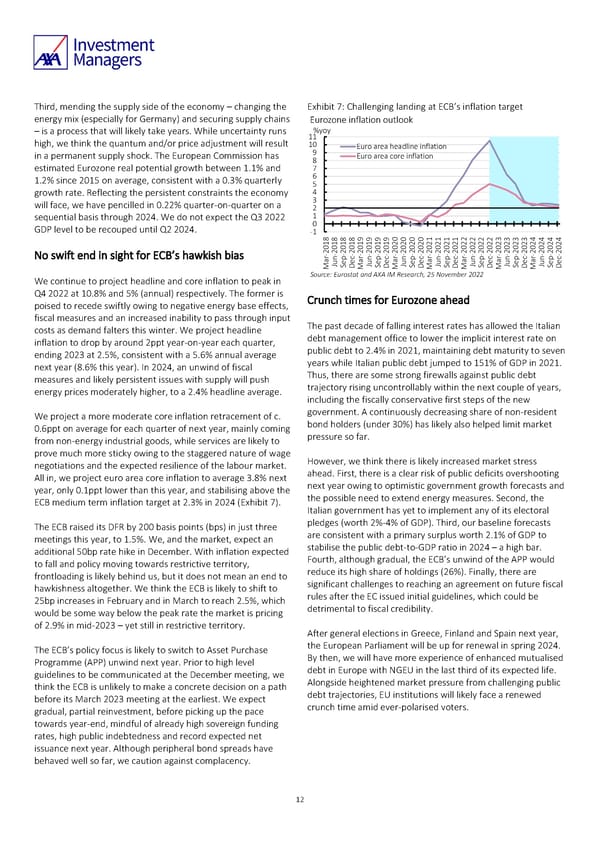Third, mending the supply side of the economy – changing the Exhibit 7: Challenging landing at ECB’s inflation target energy mix (especially for Germany) and securing supply chains Eurozone inflation outlook – is a process that will likely take years. While uncertainty runs %yoy high, we think the quantum and/or price adjustment will result 11 10 Euro area headline inflation in a permanent supply shock. The European Commission has 9 Euro area core inflation 8 estimated Eurozone real potential growth between 1.1% and 7 1.2% since 2015 on average, consistent with a 0.3% quarterly 6 5 growth rate. Reflecting the persistent constraints the economy 4 will face, we have pencilled in 0.22% quarter-on-quarter on a 3 2 sequential basis through 2024. We do not expect the Q3 2022 1 GDP level to be recouped until Q2 2024. 0 -1 8 8 8 8 9 9 9 9 0 0 0 1 1 1 1 2 2 2 2 3 3 3 3 4 4 4 4 1 01 20120110120101202 202002202202022 02202022 02202022 02202202 No swift end in sight for ECB’s hawkish bias a-20rJun-2ep-c-ar-20Jun-2ep-c-2ar-20Jun-2p-c-2ar-20Jun-2ep-c-2ar-20Jun-2ep-c-2ar-20Jun-2ep-c-2ar-20Jun-2ep-c- M S DeM S DeM SeDeM S DeM S DeM S De M S De We continue to project headline and core inflation to peak in Source: Eurostat and AXA IM Research, 25 November 2022 Q4 2022 at 10.8% and 5% (annual) respectively. The former is poised to recede swiftly owing to negative energy base effects, Crunch times for Eurozone ahead fiscal measures and an increased inability to pass through input costs as demand falters this winter. We project headline The past decade of falling interest rates has allowed the Italian inflation to drop by around 2ppt year-on-year each quarter, debt management office to lower the implicit interest rate on ending 2023 at 2.5%, consistent with a 5.6% annual average public debt to 2.4% in 2021, maintaining debt maturity to seven next year (8.6% this year). In 2024, an unwind of fiscal years while Italian public debt jumped to 151% of GDP in 2021. measures and likely persistent issues with supply will push Thus, there are some strong firewalls against public debt energy prices moderately higher, to a 2.4% headline average. trajectory rising uncontrollably within the next couple of years, including the fiscally conservative first steps of the new We project a more moderate core inflation retracement of c. government. A continuously decreasing share of non-resident 0.6ppt on average for each quarter of next year, mainly coming bond holders (under 30%) has likely also helped limit market from non-energy industrial goods, while services are likely to pressure so far. prove much more sticky owing to the staggered nature of wage negotiations and the expected resilience of the labour market. However, we think there is likely increased market stress All in, we project euro area core inflation to average 3.8% next ahead. First, there is a clear risk of public deficits overshooting year, only 0.1ppt lower than this year, and stabilising above the next year owing to optimistic government growth forecasts and ECB medium term inflation target at 2.3% in 2024 (Exhibit 7). the possible need to extend energy measures. Second, the Italian government has yet to implement any of its electoral The ECB raised its DFR by 200 basis points (bps) in just three pledges (worth 2%-4% of GDP). Third, our baseline forecasts meetings this year, to 1.5%. We, and the market, expect an are consistent with a primary surplus worth 2.1% of GDP to additional 50bp rate hike in December. With inflation expected stabilise the public debt-to-GDP ratio in 2024 – a high bar. to fall and policy moving towards restrictive territory, Fourth, although gradual, the ECB’s unwind of the APP would frontloading is likely behind us, but it does not mean an end to reduce its high share of holdings (26%). Finally, there are hawkishness altogether. We think the ECB is likely to shift to significant challenges to reaching an agreement on future fiscal 25bp increases in February and in March to reach 2.5%, which rules after the EC issued initial guidelines, which could be would be some way below the peak rate the market is pricing detrimental to fiscal credibility. of 2.9% in mid-2023 – yet still in restrictive territory. After general elections in Greece, Finland and Spain next year, the European Parliament will be up for renewal in spring 2024. The ECB’s policy focus is likely to switch to Asset Purchase By then, we will have more experience of enhanced mutualised Programme (APP) unwind next year. Prior to high level debt in Europe with NGEU in the last third of its expected life. guidelines to be communicated at the December meeting, we Alongside heightened market pressure from challenging public think the ECB is unlikely to make a concrete decision on a path debt trajectories, EU institutions will likely face a renewed before its March 2023 meeting at the earliest. We expect crunch time amid ever-polarised voters. gradual, partial reinvestment, before picking up the pace towards year-end, mindful of already high sovereign funding rates, high public indebtedness and record expected net issuance next year. Although peripheral bond spreads have behaved well so far, we caution against complacency. 12
 AXA IM Outlook 2023 full report Page 11 Page 13
AXA IM Outlook 2023 full report Page 11 Page 13